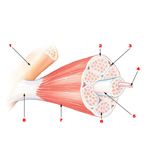Muscle Density Linked to Survival in Metastatic RCC
A high skeletal muscle density has been linked to a twofold prolonged survival in patients with metastatic renal cell carcinoma compared with patients with low muscle density, according to a new study.
A high skeletal muscle density has been linked to a twofold prolonged survival in patients with metastatic renal cell carcinoma compared with patients with low muscle density, according to a new study published in Cancer.

Skeletal muscle
“Prognostic factors for improved overall survival are lacking for patients with metastatic renal cell carcinoma because the prognosis has been improved with targeted therapies,” wrote researchers led by Sami Antoun, MD, of Institut Gustave-Roussy, France. “The results of the current study indicate that muscle density could be used as a prognostic factor and could improve the usual prognostic scores.”
Previous studies have shown a link between measurements of body composition, such as adipose tissue or skeletal muscle, and overall survival (OS), and progression-free survival. Currently, the most commonly used prognostic scores for renal cell carcinoma do not integrate these measurements, according to the researchers.
Dr. Antoun and colleagues analyzed 149 patients with metastatic renal cell carcinoma to determine if adipose tissue, skeletal muscle, and skeletal muscle density were prognostic. The patients were selected from three prospective trials examining targeted therapies: the TARGET trial, which assessed sorafenib; the RECORD trial, which assessed everolimus; and a phase II trial of sunitinib. Computed tomography was used to assess the three body composition measurements.
The median OS of 21.4 months was found to be strongly associated with skeletal muscle density. Those patients classified as having a high density had a median survival of 29 months compared with 14 months in patients with low skeletal muscle density (P = .001). In contrast, no association was found between survival and muscle area of body mass index.
“Instead of the two intermediate-risk and favorable-risk groups, we were able to establish three groups classified by an 8-month median OS (95% CI, 6 months–12 months) for patients with an intermediate-risk Heng score and low [skeletal muscle density] to a 22-month median OS (95% CI, 14 months–27 months) for patients with an intermediate-risk Heng score and high [skeletal muscle density] and a favorable-risk Heng score and low [skeletal muscle density], to a 35-month median OS (95% CI, 24 months–43 months) for patients with a favorable-risk Heng score and high [skeletal muscle density],” the researchers wrote.
The association persisted when examining progression-free survival. The median 5.5-month progression-free survival was associated with skeletal muscle density. Again, the progression-free survival was twice as long in patients classified as having high skeletal muscle density compared with low (8 months vs 4 months; P <.001).
The researchers pointed out that since the patients in this study were selected from clinical trials, the results may not reflect real-world experience.